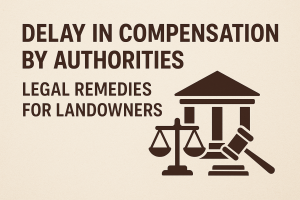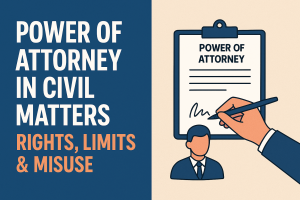The Scheduled Tribes and Other Traditional Forest Dwellers (Recognition of Forest Rights) Act, 2006 — popularly known as the Forest Rights Act (FRA) — was a landmark legislation passed to acknowledge and rectify centuries of injustice inflicted upon forest-dwelling communities. These communities, despite living on and conserving forest lands for generations, were often treated as encroachers due to the absence of legal land rights.
While the core intent of the FRA is social justice and tribal empowerment, it has also deeply impacted India’s land governance system, particularly revenue and land records administration.
Key Objectives of the Forest Rights Act, 2006
The Act seeks to:
• Recognise and vest forest rights in Scheduled Tribes (STs) and Other Traditional Forest Dwellers (OTFDs).
• Provide legal land titles for occupation and use of forest land for livelihood purposes.
• Secure community rights to forest produce, grazing areas, water bodies, and management of forest resources.
Historical Context: Disconnect Between Actual Use and Legal Record
Traditionally, land records — maintained by Revenue Departments — excluded forest-dwelling communities due to:
• Colonial forest laws that restricted community access.
• Lack of documentation or formal deeds.
• Absence of revenue settlements in forest areas.
As a result, vast numbers of forest-dependent families were invisible in official land records, leading to:
• Denial of welfare benefits
• Evictions termed as “anti-encroachment”
• Exclusion from land acquisition compensation
How the FRA Changed the Landscape
1. Conversion of Forest Land to Revenue Land
When a forest right claim is granted under FRA:
• The land is legally recorded in the name of the individual or community.
• This leads to reclassification of land from “forest land” to “revenue land”.
• Titles granted under FRA are heritable but inalienable, meaning they can’t be sold or transferred.
This requires updating of:
• Land revenue records (RoR)
• Cadastral maps
• Mutation entries
• Village and block-level data
2. Creation of New Revenue Entries (RoR)
For most claimants, especially in tribal belts, this is the first instance of legal landholding.
The Revenue Department is mandated to:
• Register the land parcel
• Generate a Record of Rights (7/12 extract, Khata, Patta, etc.)
• Issue joint titles to husband and wife
• Mark the land on cadastral and GIS maps
This process is complex due to:
• Overlapping jurisdictions of Forest and Revenue departments
• Absence of ground demarcation
• Resistance from local authorities unfamiliar with tribal customary claims
3. Challenge of Integrating Community Forest Rights (CFR)
Under Section 3(1)(i) of FRA, Gram Sabhas can claim rights over:
• Grazing lands
• Water sources
• Forest produce (bamboo, tendu, mahua, etc.)
• Community forest management
Once granted:
• These lands are managed by the community
• The control shifts from Forest Department to Gram Sabha
• Revenue departments must reflect community ownership in land records — a shift from individual title models
Many states still struggle to update their land record systems to accommodate collective ownership models under CFR.
4. Impact on Government Land Banks and Acquisition Projects
FRA has created a mandatory process for obtaining consent from Gram Sabhas before using forest land for:
• Infrastructure projects
• Industrial corridors
• Mining leases
• Resettlement plans
Section 4(5) prohibits eviction or removal until claims are fully settled. This means:
• States must identify and record FRA lands before acquisition.
• Failure to do so makes acquisition illegal.
In turn, this reduces the availability of undisputed “government land” for public-private projects, reshaping state revenue strategies and land pooling models.
5. Revenue Disputes and Judicial Backlog
Numerous challenges have emerged:
• Forest rights granted but mutation not done
• Titles issued but not reflected in survey maps
• Inconsistent practices across states regarding format and validity of FRA titles
• Cases where claims were rejected without proper hearing, leading to litigation
Several High Courts have intervened, directing state governments to:
• Digitise FRA claims
• Maintain updated village-wise land ownership registers
• Recognise Gram Sabha as a statutory authority under land governance
Institutional & Administrative Challenges
Despite its transformative potential, FRA’s implementation faces serious bottlenecks:
| Challenge | Description |
| Legal Ambiguity | No uniform procedure to reflect FRA titles in revenue records across states |
| Inter-departmental Delays | Revenue and Forest Departments often pass responsibility to each other |
| Survey Issues | Poorly maintained maps, absence of GIS-based demarcation |
| Lack of Training | Revenue officials lack awareness about FRA mandates |
| Political Sensitivity | Some vested interests resist recognition of tribal claims due to resource value of forest lands |
Noteworthy Cases and Developments
• Supreme Court (2019) stayed eviction orders of rejected claimants, highlighting the need for proper verification and appeals.
• Niyamgiri Case (Orissa Mining Corporation v. Ministry of Environment, 2013) – Affirmed the primacy of Gram Sabha in forest land decisions under FRA.
• Maharashtra and Chhattisgarh have started recording community forest areas on government portals (Bhulekh/BhuNaksha).
Way Forward: Recommendations
1. Integration of FRA Data with Digital India Land Records Modernization Programme (DILRMP)
2. Unified national guideline for recording and updating FRA titles in revenue records
3. Dedicated Revenue Officers at block level to handle tribal and forest land claims
4. Use of GPS and GIS tools for transparent boundary marking
5. Enabling legal awareness and paralegal training for Gram Sabha members
Conclusion
The Forest Rights Act is a historic shift from denial to recognition, from exclusion to inclusion. But its promise can only be fulfilled when legal rights are translated into recorded rights — when the names, boundaries, and usage of tribal lands appear clearly in the official revenue system.
By harmonising the social justice vision of FRA with the administrative machinery of revenue law, India can build a land governance model rooted in justice, clarity, and sustainability.



